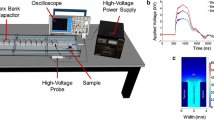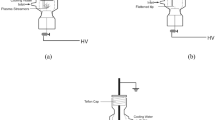Summary
Bacteria of the typeE. coli K12 have been treated in experiments using high-voltage pulses of short time (µs) as a killing agent. The role of different experimental parameters has been studied: kind of electrolyte, concentration, length of pulses, field strength, pH and temperature. Electrolytes with bivalent cations were found to reduce the lethal action. The relative rate of killed bacteria was shown to be mainly governed by the field strength and the treatment time, which is defined by the product of pulse number and decay time constant. From the obtained results a function has been developed which enables the precalculation of the killing rate forE. coli, provided that certain limits of experimental conditions are considered. No correlation between the applied electric energy and the lethal effect could be found.
Similar content being viewed by others
References
Schwan HP (1977) Field interaction with biological matter. Ann NY Acad Sci 303: 198–231
Zimmermann U, Pilwat G, Riemann F (1974) Dielectric breakdown of cell membranes. Biophys J 14: 881–899
Zimmermann U, Pilwat G, Riemann F (1976) Effects of external electrical fields on cell membranes. Bioel Bioen 3: 58–83
Sale AJH, Hamilton WA (1967) Effects of high electric fields on microorganisms I. and II. Biochim Biophys Acta 148: 781–800
Sale AJH, Hamilton WA (1968) Effects of high electric fields on microorganisms III. Biochim Biophys Acta 163: 37–43
Hülsheger H, Niemann EG (1980) Lethal effects of high voltage pulses onE. coli K12. Radiat Environ Biophys 18: 281–288
Sakarauchi Y, Kondo E (1980) Lethal effects of high electric fields on microorganisms. J Agricult Chem Soc Jpn 54: 837–844
Schwan, HP (1957) Electrical properties of tissue and cell suspensions. Adv Biol Med Phys 5: 147–209
Asami K, Hanai T, Koizumi N (1980) Dielectric analysis of Escherichia coli suspensions in the light of the theory of interfacial polarisation. Biophys J 31: 215–228
Leive L (1966) Release of lipopolysaccharide by EDTA treatment ofE. coli. Biochem Biophys Res Commun 22: 664–671
Asbell MA, Eagon RG (1966) The role of multivalent cations in the organisation and structure of bacterial cell walls. Biochem Biophys Res Commun 22: 664–671
Zimmermann U, Schulz J, Pilwat G (1973) Transcellular ion flow in Escherichia coli B and electrical sizing of bacterias. Biophys J 13: 1005–1013
Author information
Authors and Affiliations
Rights and permissions
About this article
Cite this article
Hülsheger, H., Potel, J. & Niemann, E.G. Killing of bacteria with electric pulses of high field strength. Radiat Environ Biophys 20, 53–65 (1981). https://doi.org/10.1007/BF01323926
Received:
Accepted:
Issue Date:
DOI: https://doi.org/10.1007/BF01323926




